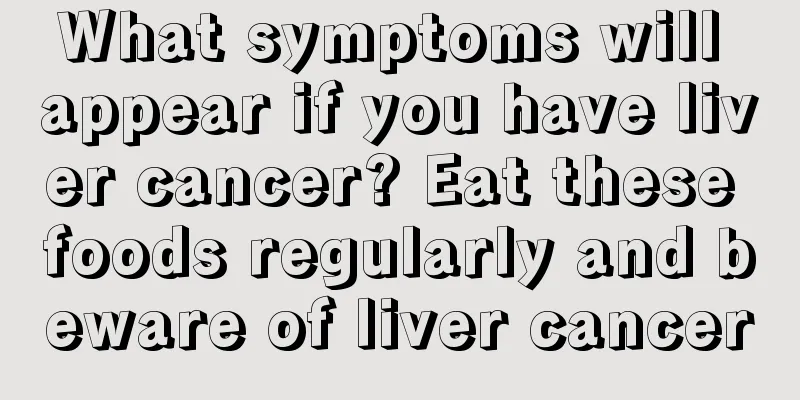What symptoms will appear if you have liver cancer? Eat these foods regularly and beware of liver cancer

|
The main cause of liver cancer is the malignant transformation of hepatitis, but aflatoxin in the diet is also one of the causes of liver cancer. Let’s take a look at which foods are likely to induce liver cancer. Beware of liver cancer if you eat these foods regularly Moldy food often contains fungi, and aflatoxin in fungi is a carcinogen that can induce liver cancer in humans, monkeys, mice, and poultry. The shortest time required to cause cancer is 24 weeks. Preventing fungal contamination of food is also a way to prevent liver cancer. You should pay attention to: 1. Peanuts, corn, sweet potatoes, rice, millet, etc. stored at home must be dried thoroughly and stored in a dry and ventilated environment. 2. Moldy peanuts, dried potatoes, dried radishes, etc. should be discarded and cannot be eaten by humans, livestock or poultry. 3. Peanut oil and cottonseed oil should not be stored for a long time. When a large amount of grain, oil or dairy products are suspected to be contaminated with fungi, the quarantine station should be asked to check and they can only be distributed, sold or consumed after approval. Stale oils contain a chemical component that can cause the structure of proteins to mutate, causing cells with mutated proteins to lose their normal functions and transform into early cancer cells. In addition, the replication of acids in some chemical components accelerates the aging process. Therefore, animal and vegetable oils should not be stored for too long, and oils that have deteriorated and have a rancid smell should not be eaten. Foods fried in rancid oils not only taste bad, but more importantly, they can cause liver cancer and shorten life expectancy. What are the symptoms of liver cancer? 1. Obvious loss of appetite: abdominal distension, indigestion, sometimes nausea and vomiting; 2. Dull pain in the right upper abdomen: There may be persistent or intermittent pain in the liver area, which may sometimes be aggravated by changes in body position. Liver cancer is harmful to health and well-being. 3. Fatigue, weight loss, unexplained fever and edema; 4. Jaundice, ascites, and skin itching; 5. It often manifests as nose bleeding, subcutaneous bleeding, etc. 6. Fever The fever caused by liver cancer is generally around 37.5℃~38℃, occasionally reaching above 39℃, with irregular fever pattern, usually without chills, and more common in the afternoon, sometimes with remittent high fever. Fever can be caused by tumor necrosis or its metabolites. 7. Other symptoms include hepatitis, cirrhosis, or large infiltrative tumor growth leading to liver decompensation. Patients may have a tendency to bleed, such as gum and nose bleeding and subcutaneous ecchymosis. They may also have hypoproteinemia, edema, ascites, abdominal distension, etc. Tumor metastasis to the lungs may cause coughing. When the tumor invades and blocks the hepatic vein or inferior vena cava, progressive lower limb edema may occur, and even ascites and other manifestations of Budd-Chiari syndrome may occur. |
Recommend
What are the benefits of drinking wolfberry soaked in water
As we all know, wolfberry has the effects of impr...
What are the dangers of white precipitate in urine
Some patients with white precipitate in urine are...
Fish and pork, which one is more carcinogenic after being heated twice? Doctor: These 4 categories! It is better to eat it cold, not to reheat it
The small kitchen of Aunt Zhang's home was fi...
Postoperative recurrence examination for colorectal cancer
Some people who have undergone radical surgery fo...
What are the symptoms of kidney cancer?
Kidney cancer refers to renal cell carcinoma, whi...
Will taking vitamin E make you fat?
Unlike other types of vitamins, vitamin E is a fa...
The difference between tonsils and thyroid
Tonsils and thyroid are completely different orga...
What foods are good for nourishing the spleen?
A diet that strengthens the spleen is more effect...
How to prevent lung cancer recurrence? Three tips to prevent and treat lung cancer recurrence
Although the incidence of lung cancer is increasi...
How to remove oil stains on the wall
In the past, there was no habit of laying tiles i...
How to do manual CPR?
The heart is the most important organ in the huma...
What to do if you have high blood pressure and low blood pressure? It is caused by these reasons
High diastolic pressure is a common phenomenon of...
Is anti-inflammatory toothpaste good?
Toothpaste has a certain effect in inhibiting bac...
What are the effects and functions of moxa sticks?
Moxa sticks usually have many functions. First of...
What to do if my back hurts due to poor breathing
A stitch in the side is a very common phenomenon....









